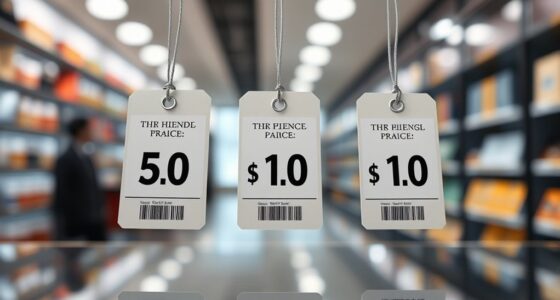Watch out for psychological pricing tricks like prices ending in .99 or .95, which make items seem cheaper. Retailers also use decoy options, bundling, and strategic placement to make deals look more appealing. Limited-time offers and scarcity tactics create urgency, while visual cues, sound, and language amplify perceived value. Recognizing these subtle techniques can help you make smarter choices and spot beyond-the-surface strategies that influence your spending. If you keep exploring, you’ll find even more ways marketers shape your decisions.
Key Takeaways
- Be cautious of prices ending in .99 or .95, which create a perception of bargain and affordability.
- Watch for decoy pricing strategies where higher-priced items make mid-range options seem more attractive.
- Recognize strategic price placement, like high prices next to discounts, to enhance perceived deals.
- Be aware of the left-digit effect, where prices just below round numbers appear more appealing.
- Notice visual cues such as bold colors or placement at eye level that influence impulsive purchasing decisions.
The Power of Charm Pricing: Why $9.99 Feels Cheaper Than $10
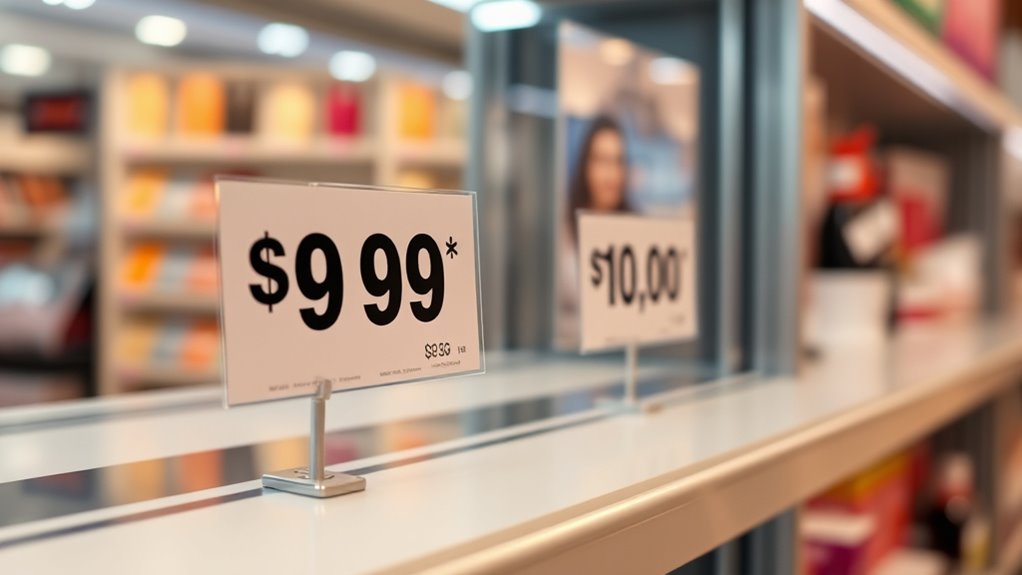
You might notice that many prices end in .99, but have you ever wondered why? It’s because charm pricing leverages our subconscious perception that $9.99 is notably cheaper than $10. Even though the difference is just one cent, your brain perceives $9.99 as a better deal. This occurs because your mind focuses on the first digit, so $9.99 appears closer to $9 than to $10. Retailers use this trick to make prices seem more appealing, encouraging you to make a purchase without consciously realizing it. The effect taps into your tendency to view prices just below a round number as a bargain, making you more likely to buy. Understanding pricing perception can help consumers become more aware of how pricing strategies influence their buying decisions. Charm pricing subtly influences your buying decisions, often increasing sales for products priced just under a dollar threshold. Recognizing psychological pricing tricks can empower consumers to make more mindful shopping choices. Additionally, research from sound healing science suggests that subtle cues in marketing, like price endings, can significantly impact consumer behaviors. Recognizing consumer behavior patterns can further enhance awareness of these subtle influences.
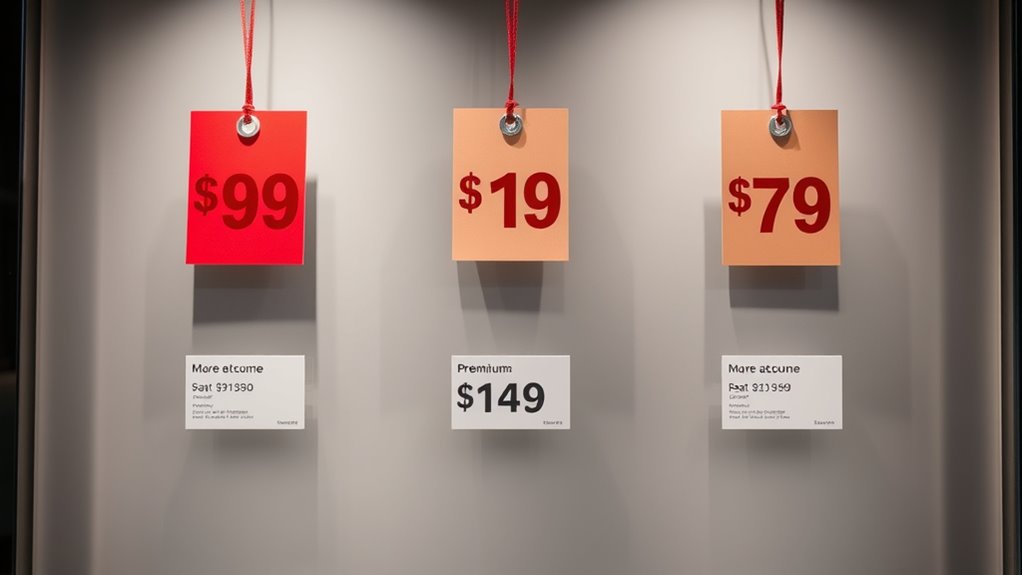
You can influence how customers perceive value by offering premium and discounted options side by side. Setting clear price tiers helps customers compare and make quicker decisions. The way you position these prices impacts how attractive each option appears. Incorporating aesthetic wall organization elements into your pricing display can further enhance visual appeal and perceived value. Additionally, understanding the differences between personality traits, such as those identified in 16PF, can help tailor marketing strategies to different customer types, increasing the effectiveness of your pricing tactics.
By offering both premium and discounted options, businesses can effectively anchor prices and influence customer perceptions. This strategy makes the higher-priced item seem more valuable and the lower-priced option more affordable. Customers compare the tiers, often choosing based on perceived value rather than cost alone. To maximize this effect, consider these tactics:
- Place the premium option prominently to highlight its features and justify the higher price.
- Price the mid-tier to serve as a comparison point, making the premium seem even more attractive.
- Use visual cues like size or placement to draw attention to the premium and discount options, guiding customer choices seamlessly.
- Incorporate knowledge of business pricing strategies to create appealing product displays that enhance perceived value and encourage selection of higher-tier options. Additionally, understanding consumer behavior can help tailor these displays to influence purchasing decisions more effectively. Recognizing appliance maintenance plans can also help highlight the long-term savings and value in higher-tier offerings, making them more attractive to consumers. Implementing psychological pricing techniques can further reinforce the perceived differences between tiers and influence buying decisions.
Perceived Value Strategies
Understanding how to shape customer perceptions begins with strategic price positioning. Anchoring prices is a powerful tactic that influences what customers see as valuable. By offering a premium option alongside a standard one, you create a reference point that makes the standard seem more affordable and reasonable. Conversely, presenting a heavily discounted option next to a higher-priced item can make the discount appear more significant. This perception encourages customers to see deals as better value. You can also use a high-priced, rarely purchased item to make other options seem more attractive. The key is to set expectations and guide customer choices naturally, so they feel confident they’re getting a good deal without feeling pressured. Employing psychological pricing tricks like these can subtly influence customer behavior and decision-making. This perceived value boosts conversions and enhances overall satisfaction.
Price Placement Impact
Anchoring prices effectively sets customer expectations and influences their perception of value. When you place a high-priced item next to a discounted option, it makes the discount seem more attractive, encouraging purchases. Conversely, showing a premium product first establishes a higher baseline, making other options appear more affordable. Your goal is to guide customers toward the desired choice by strategically positioning prices. Additionally, understanding pricing psychology can help you craft more effective pricing strategies that influence buying behavior. Recognizing perceived value and how it varies with price placement can further optimize your sales approach. Properly managing price perception can lead to increased customer satisfaction and sales conversion rates.
The Left-Digit Effect: How Leading Numbers Influence Our Perception of Value

You may notice that prices ending in just below a round number often seem more appealing. The first digit has a powerful effect on how you perceive the item’s value. This left-digit impact can shift your perception, making some prices feel more affordable than they actually are. Additionally, this psychological pricing tactic is widely used in markets like the tea industry, where consumers are influenced by subtle pricing cues to make purchasing decisions.
Left-Digit Impact on Pricing
The left-digit effect reveals how the first number in a price considerably influences your perception of its value. When you see prices like $9.99 instead of $10.00, your brain often perceives the item as markedly cheaper, even though the difference is just a cent. This is because your mind focuses on the first digit, making the price seem more attractive. Retailers leverage this trick to boost sales by setting prices just below a round number. Additionally, understanding how perception of value is shaped by pricing strategies can help consumers make more informed decisions. Recognizing these psychological pricing tricks allows shoppers to be more aware of subtle tactics designed to influence their purchasing choices.
Perceived Value Shift
The left-digit effect profoundly shapes how you perceive the value of a product or service. When a price drops from $100 to $99.99, your mind shifts from perceiving it as over $100 to just under $100, making it seem markedly cheaper. This perceived value shift influences your purchasing decisions, often leading you to choose the lower-priced option even if the actual difference is minimal. Retailers exploit this by pricing items just below a round number, creating the illusion of a better deal. Your brain automatically compares the leading digits rather than the full amount, which can make a small difference seem substantial. Recognizing this trick helps you make more informed choices and avoid being swayed by seemingly significant price drops that are actually minimal.
Limited-Time Offers and Scarcity: Creating Urgency to Boost Sales
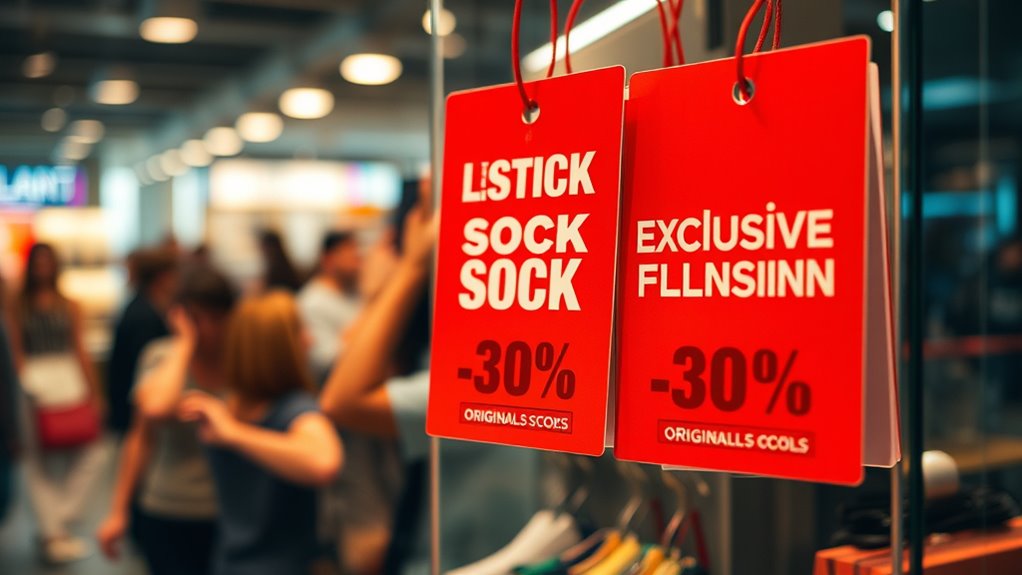
Limited-time offers and scarcity tactics create a sense of urgency that encourages quick decision-making. When you see a deal available only for a short period or limited stock, you’re more likely to act fast to avoid missing out. These strategies tap into your fear of missing an opportunity, pushing you toward immediate purchases. By highlighting scarcity, marketers make products seem more valuable and desirable. Additionally, understanding the psychological principles behind pricing tricks can help consumers recognize when they are being influenced. Here are some common tactics you might encounter:
- Countdown timers that show limited time remaining
- Limited stock messages like “Only 3 left!”
- Exclusive offers available to a select group or for a brief window
Incorporating these tactics into your marketing strategy can enhance topical authority and drive higher conversions. Recognizing these tricks can also reveal how dependence on cloud services may introduce vulnerabilities, making it essential to stay cautious and informed to stay in control and make more rational decisions, rather than impulsive ones driven by perceived urgency. For example, some marketers use psychological pricing to further influence your perception of value and urgency.
The Decoy Pricing Strategy: Making Higher-Priced Items Look More Attractive

You can make higher-priced items seem more appealing by comparing different price tiers side by side. Highlighting the value differences helps you see the benefits clearly, guiding your decision to choose the more expensive option. This strategy steers your purchase choices without you even realizing it.
Comparing Price Tiers
When businesses introduce multiple price options, they often use a tactic called the decoy strategy to influence your perception of value. This involves comparing different tiers to make certain options seem more attractive. You might notice a mid-priced product that appears more appealing because it offers better value compared to a much higher-priced item. This encourages you to choose the middle option, thinking you’re getting a good deal. To spot this tactic, look for:
- A high-priced item that seems overly expensive but makes other options look affordable
- A middle-tier product that appears to offer the best value
- Price differences that seem designed to steer you toward a specific choice
Understanding these comparisons helps you make more informed decisions, rather than falling for subtle marketing tricks.
Highlighting Value Differences
Businesses often highlight differences in value between options to make higher-priced items seem more appealing. They do this by placing a premium product next to a slightly better, but more expensive, option. This makes the higher-priced item look like the best deal. Here’s a simple comparison:
| Option | Features | Price |
|---|---|---|
| Basic Package | Standard features | $50 |
| Premium Package | Extra features, better quality | $80 |
| Decoy Package | Slightly more features, higher price | $100 |
| Higher-End Model | All features, top quality | $150 |
The decoy price makes the higher-end model seem more attractive and worth the extra investment. It guides you toward the more expensive choice by emphasizing value differences.
Steering Purchase Decisions
The decoy pricing strategy guides your decisions by making higher-priced options seem more attractive. When you see a mid-range product alongside a much more expensive one, the higher-priced item appears more reasonable and desirable. This technique steers you toward choosing the option that benefits the seller most. You might find yourself convinced that the higher-priced product offers better value, even if it’s unnecessary for your needs.
To recognize this tactic:
- Look for a third option designed solely to make another seem affordable
- Notice when the most expensive item is considerably priced higher
- Be cautious of comparisons that highlight features but omit value differences
Price Ending Tricks: The Impact of Using Zeroes and Nines at the End of Prices

Price ending tricks leverage the way consumers perceive numbers, with the use of zeros and nines at the end of prices playing a crucial role. When you see a price like $9.99 instead of $10, your brain often interprets it as a better deal, even if the difference is just a penny. This tactic creates a sense of savings or value, making you more likely to make a purchase. Retailers frequently use prices ending in .99 or .95 because they trigger a subconscious perception of affordability. Conversely, rounded figures like $10 or $20 can seem more expensive or premium. By understanding these subtle cues, you can recognize when prices are designed to influence your perception, allowing you to make more conscious buying decisions.
Bundle Pricing: Making Packages Seem Like Greater Value Than Individual Items

When retailers combine multiple items into a single package, they create an illusion of greater value that can influence your purchasing decision. This strategy makes you feel you’re getting more for your money, even if the overall price isn’t a real bargain. By bundling products, they encourage you to buy more than you initially planned. To make the package appealing, they often:
- Price the bundle slightly below the total of individual items, emphasizing savings
- Highlight the convenience of buying everything in one go
- Use attractive packaging or branding to make the deal look exclusive
These tactics tap into your desire for value and simplicity, making you more likely to choose a bundle over individual purchases. Stay aware of how these tricks influence your perception of worth.
The Illusion of Savings: Highlighting Discounts to Mask Higher Original Prices
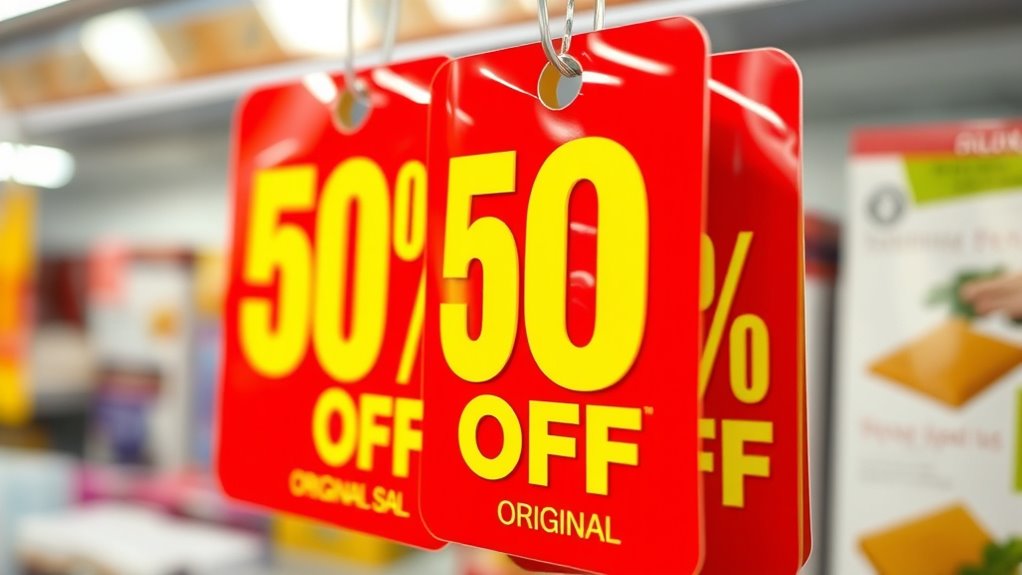
Retailers often highlight discounts to make you believe you’re saving more than you actually are, even if the original prices were inflated. They might list a high “original” price that’s artificially inflated, then show a lower sale price to create a sense of savings. This tactic shifts your focus from the true value to the perceived discount, making the deal seem more attractive. Sometimes, the original price isn’t realistic or comparable to what you’d normally pay, but the discount still appears significant. By emphasizing the savings, retailers encourage impulse buying, even if the final price isn’t a genuine bargain. Always question whether the original price is fair and comparable, rather than just accepting the discount at face value.
Psychological Pricing in Store Displays: How Visual Cues Influence Spending
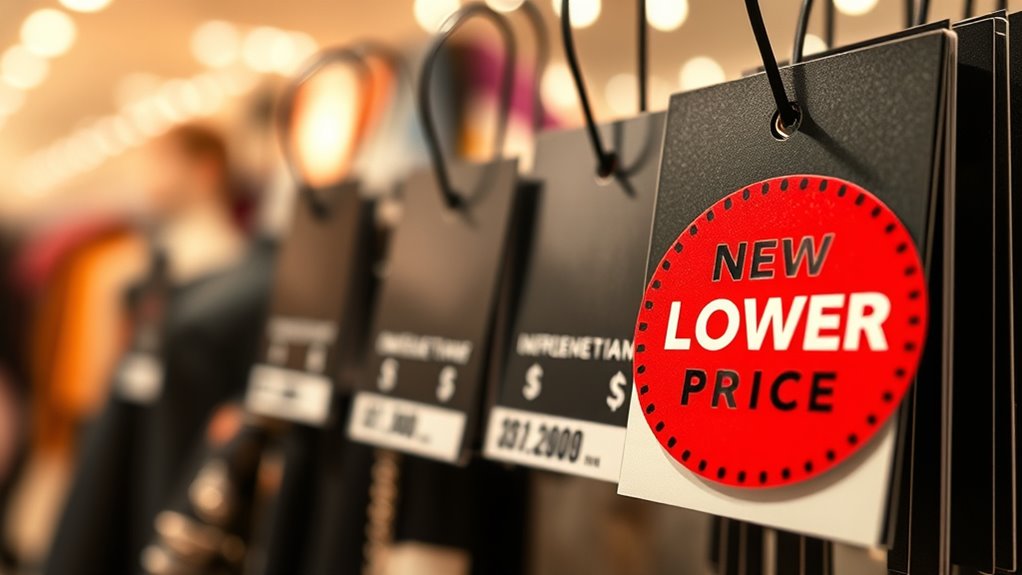
Store displays are carefully designed to influence your spending through visual cues that tap into your subconscious. They use strategic placement, color schemes, and labeling to make prices seem more appealing or affordable. For example, placing items at eye level draws your attention, while warm colors like red and orange evoke urgency or excitement. The use of smaller fonts for prices or “compare at” prices can make deals look more attractive. Additionally, grouping products into themed displays encourages impulse purchases by creating a sense of abundance. These visual tricks subtly guide your choices without you realizing it. By understanding these cues, you can become more mindful of how displays influence your purchasing decisions and avoid falling for their psychological tricks.
The Impact of Sound and Language in Pricing Promotions
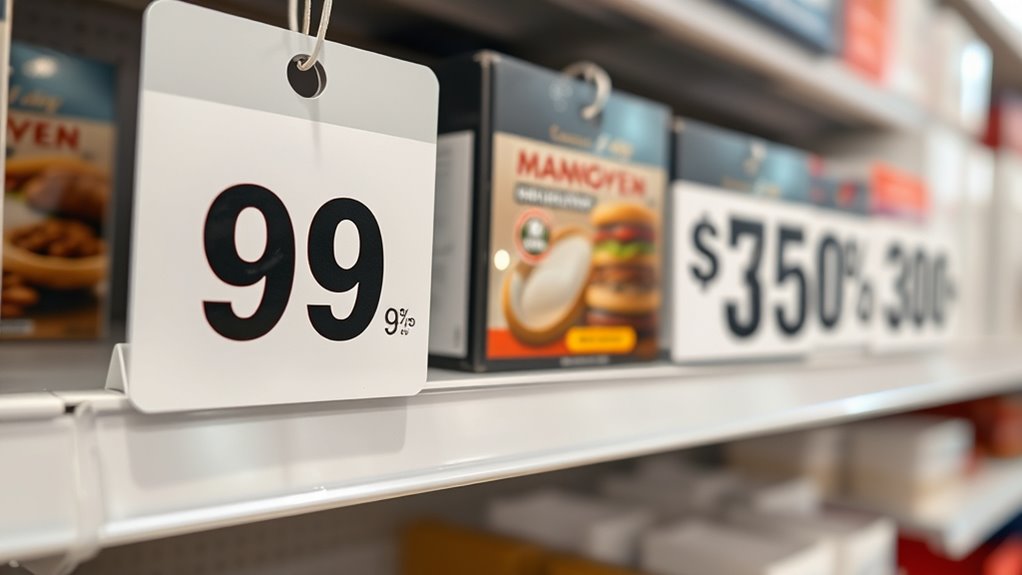
Sound and language play powerful roles in shaping your perception of pricing promotions. The words used and sounds heard can influence how attractive a deal feels. For example, a store might call a discount “special savings” or use a tone that sounds urgent to create excitement. The right language can make a price seem lower or more valuable. Similarly, sounds like chimes or upbeat music can boost your mood, making you more receptive to offers. Here’s a quick look at how different elements influence you:
| Element | Effect | Example |
|---|---|---|
| Words | Create urgency and value | “Limited time offer” |
| Tone of Voice | Builds excitement or trust | Cheerful, confident speech |
| Sounds | Enhance mood and attention | Upbeat music, chimes |
These techniques subtly persuade you to spend more.
Frequently Asked Questions
How Do Retailers Decide Which Pricing Strategy to Use?
When choosing a pricing strategy, you consider your target audience, product type, and market competition. You analyze how customers perceive value and what triggers their buying decisions. Your goal is to set prices that maximize sales and profit while aligning with your brand image. You might experiment with different approaches, like discounts or charm pricing, to see what resonates best. Ultimately, your strategy hinges on understanding customer psychology and market dynamics.
Can Psychological Pricing Backfire and Reduce Sales?
Imagine a shopper eyeing a $99.99 item, feeling smart about saving a dollar, but then they notice it’s actually priced at $120 elsewhere. Psychological pricing can backfire if consumers feel manipulated or question your honesty. You risk losing trust, which can lead to decreased sales and damaged reputation. Always balance clever tactics with transparency, so customers feel valued rather than tricked, ensuring long-term loyalty.
Are These Pricing Tricks Ethical or Manipulative?
You might wonder if using these pricing tricks is ethical or manipulative. While they can influence purchasing decisions, it’s important to reflect on transparency and honesty. If you use tactics that deceive or mislead customers, it can damage trust and reputation. However, when employed responsibly to highlight value or discounts, these tricks can be ethical. Ultimately, balancing persuasive strategies with integrity helps maintain a positive relationship with your customers.
How Can Consumers Recognize and Resist These Tactics?
Imagine you’re a savvy sailor steering through a sea of prices. To recognize tricks, stay alert to charm pricing like $9.99, which seems cheaper but isn’t. Question sales that seem too good to be true, and compare prices across stores. Resist impulse buys by pausing and asking yourself if you really need the item. Being aware and cautious keeps you from falling for these clever but manipulative tactics.
Do These Techniques Work Equally Across Different Cultures?
You might wonder if these pricing tricks work the same everywhere. In reality, their effectiveness varies across cultures because of different values, shopping habits, and perceptions of price. For example, some cultures might be more sensitive to round numbers, while others focus on the overall value. So, you should consider cultural factors when analyzing or using these tactics, as what works in one place may not in another.
Conclusion
So, next time you’re tempted by that “limited-time” deal or dazzled by a “discount,” remember—you’re just a savvy shopper, not a victim. These pricing tricks are masterfully designed to make you part with your cash faster than you can say “bargain.” Congratulations on your newfound awareness; now you can stroll past the charm pricing and decoy strategies with the confidence of a seasoned connoisseur—at least, until your next purchase.


